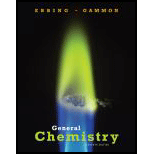
(a)
Interpretation:
In third row of periodic table given elements forms type of solid has to be predicted.
Aluminium
Concept introduction:
Types of solid
- Molecular solid
- Metallic solid
- Ionic solid
- Covalent network
Molecular solid:
A solid which consist of atoms or molecule thought intermolecular force.
Metallic solid:
The solid which consist of metal atom held together by metallic bonds. Metallic bonding is
Ionic solid:
A solid which consist of anions and cations held together by ionic bond (electrical attraction of opposite charges).
Covalent network:
A solid that involves atoms held together by great network or shackles by covalent bonds.
Diamond and graphite are great example.
(b)
Interpretation:
In third row of periodic table given elements forms type of solid has to be predicted.
Silicon
Concept introduction:
Types of solid
- Molecular solid
- Metallic solid
- Ionic solid
- Covalent network
Molecular solid:
A solid which consist of atoms or molecule thought intermolecular force.
Metallic solid:
The solid which consist of metal atom held together by metallic bonds. Metallic bonding is chemical bond formed by attraction between cation of metal and the surrounding sea of electrons.
Ionic solid:
A solid which consist of anions and cations held together by ionic bond (electrical attraction of opposite charges).
Covalent network:
A solid that involves atoms held together by great network or shackles by covalent bonds.
Diamond and graphite are great example.
(c)
Interpretation:
In third row of periodic table given elements forms type of solid has to be predicted.
Phosphorous
Concept introduction:
Types of solid
- Molecular solid
- Metallic solid
- Ionic solid
- Covalent network
Molecular solid:
A solid which consist of atoms or molecule thought intermolecular force.
Metallic solid:
The solid which consist of metal atom held together by metallic bonds. Metallic bonding is chemical bond formed by attraction between cation of metal and the surrounding sea of electrons.
Ionic solid:
A solid which consist of anions and cations held together by ionic bond (electrical attraction of opposite charges).
Covalent network:
A solid that involves atoms held together by great network or shackles by covalent bonds.
Diamond and graphite are great example.
(d)
Interpretation:
In third row of periodic table given elements forms type of solid has to be predicted.
Sulphur
Concept introduction:
Types of solid
- Molecular solid
- Metallic solid
- Ionic solid
- Covalent network
Molecular solid:
A solid which consist of atoms or molecule thought intermolecular force.
Metallic solid:
The solid which consist of metal atom held together by metallic bonds. Metallic bonding is chemical bond formed by attraction between cation of metal and the surrounding sea of electrons.
Ionic solid:
A solid which consist of anions and cations held together by ionic bond (electrical attraction of opposite charges).
Covalent network:
A solid that involves atoms held together by great network or shackles by covalent bonds.
Diamond and graphite are great example.
Want to see the full answer?
Check out a sample textbook solution
Chapter 11 Solutions
General Chemistry - Standalone book (MindTap Course List)
- V Biological Macromolecules Drawing the Haworth projection of an aldose from its Fischer projection Draw a Haworth projection of a common cyclic form of this monosaccharide: H C=O HO H HO H H OH CH₂OH Explanation Check Click and drag to start drawing a structure. Xarrow_forwardComplete the mechanismarrow_forwardComplete the mechanismarrow_forward
- 8 00 6 = 10 10 Decide whether each of the molecules in the table below is stable, in the exact form in which it is drawn, at pH = 11. If you decide at least one molecule is not stable, then redraw one of the unstable molecules in its stable form below the table. (If more than unstable, you can pick any of them to redraw.) Check OH stable HO stable Ounstable unstable O OH stable unstable OH 80 F6 F5 stable Ounstable X Save For Later Sub 2025 McGraw Hill LLC. All Rights Reserved. Terms of Use | Privacy C ཀྭ་ A F7 매 F8 F9 4 F10arrow_forwardJust try completing it and it should be straightforward according to the professor and TAs.arrow_forwardThe grading is not on correctness, so if you can just get to the correct answers without perfectionism that would be great. They care about the steps and reasoning and that you did something. I asked for an extension, but was denied the extension.arrow_forward
 World of Chemistry, 3rd editionChemistryISBN:9781133109655Author:Steven S. Zumdahl, Susan L. Zumdahl, Donald J. DeCostePublisher:Brooks / Cole / Cengage LearningChemistry: Matter and ChangeChemistryISBN:9780078746376Author:Dinah Zike, Laurel Dingrando, Nicholas Hainen, Cheryl WistromPublisher:Glencoe/McGraw-Hill School Pub Co
World of Chemistry, 3rd editionChemistryISBN:9781133109655Author:Steven S. Zumdahl, Susan L. Zumdahl, Donald J. DeCostePublisher:Brooks / Cole / Cengage LearningChemistry: Matter and ChangeChemistryISBN:9780078746376Author:Dinah Zike, Laurel Dingrando, Nicholas Hainen, Cheryl WistromPublisher:Glencoe/McGraw-Hill School Pub Co Chemistry: Principles and PracticeChemistryISBN:9780534420123Author:Daniel L. Reger, Scott R. Goode, David W. Ball, Edward MercerPublisher:Cengage Learning
Chemistry: Principles and PracticeChemistryISBN:9780534420123Author:Daniel L. Reger, Scott R. Goode, David W. Ball, Edward MercerPublisher:Cengage Learning Chemistry by OpenStax (2015-05-04)ChemistryISBN:9781938168390Author:Klaus Theopold, Richard H Langley, Paul Flowers, William R. Robinson, Mark BlaserPublisher:OpenStax
Chemistry by OpenStax (2015-05-04)ChemistryISBN:9781938168390Author:Klaus Theopold, Richard H Langley, Paul Flowers, William R. Robinson, Mark BlaserPublisher:OpenStax ChemistryChemistryISBN:9781305957404Author:Steven S. Zumdahl, Susan A. Zumdahl, Donald J. DeCostePublisher:Cengage Learning
ChemistryChemistryISBN:9781305957404Author:Steven S. Zumdahl, Susan A. Zumdahl, Donald J. DeCostePublisher:Cengage Learning Chemistry: An Atoms First ApproachChemistryISBN:9781305079243Author:Steven S. Zumdahl, Susan A. ZumdahlPublisher:Cengage Learning
Chemistry: An Atoms First ApproachChemistryISBN:9781305079243Author:Steven S. Zumdahl, Susan A. ZumdahlPublisher:Cengage Learning





